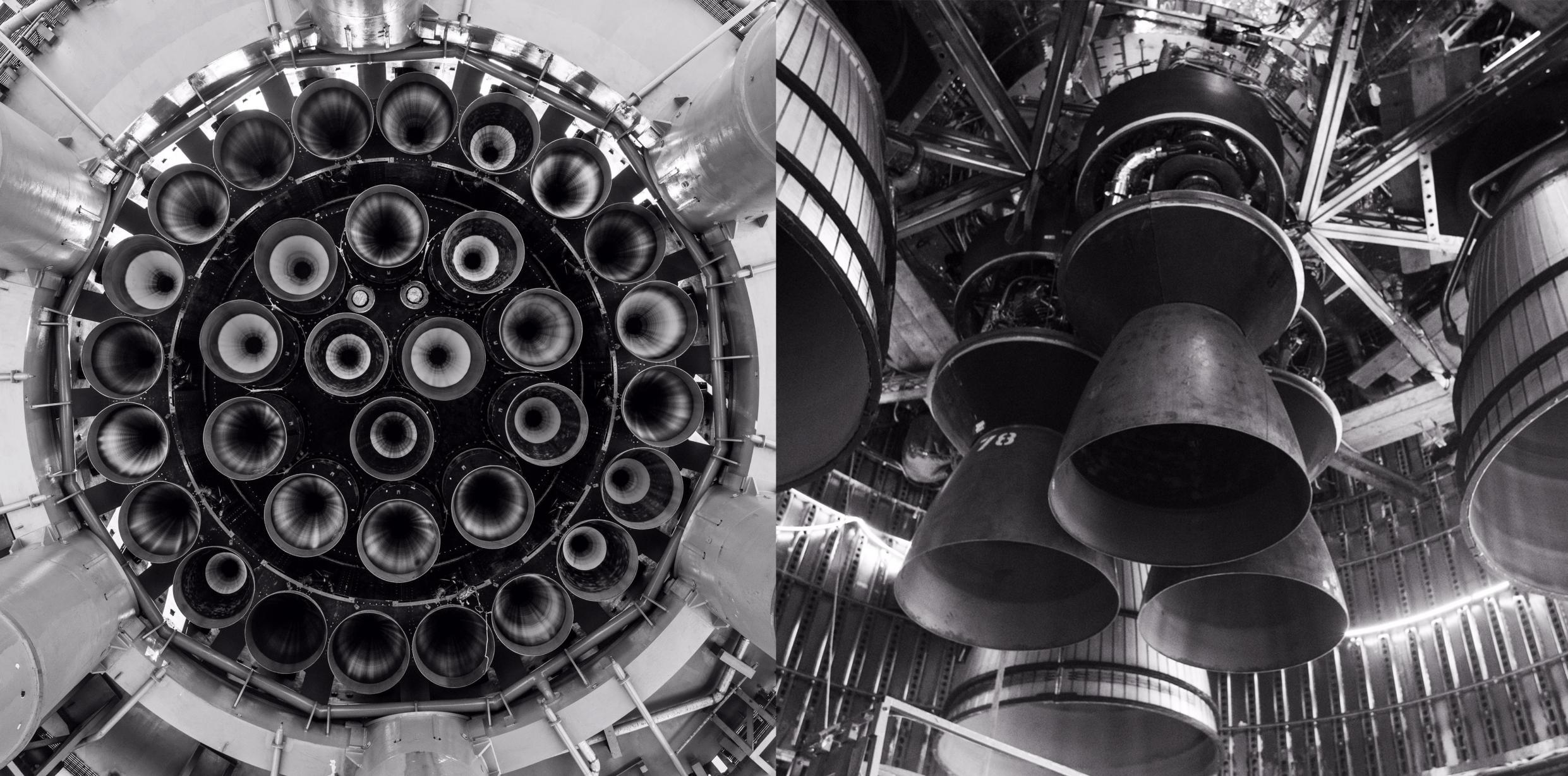
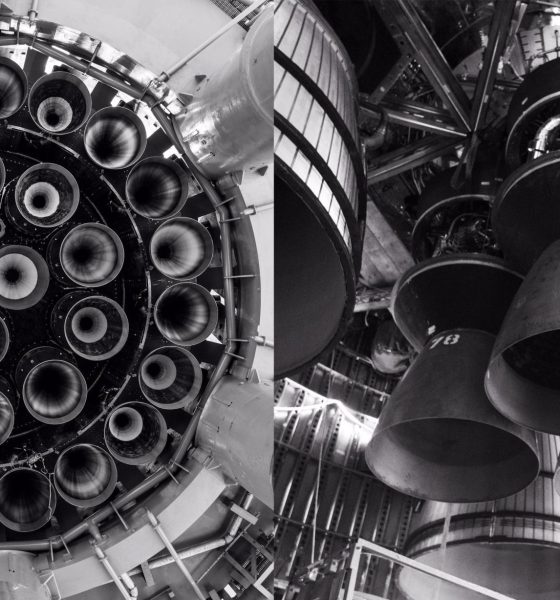
News
SpaceX outfits Starship, Super Heavy with dozens of Raptor engines
New photos shared by SpaceX show that the company has nearly finished installing a total of 39 upgraded Raptor engines on a new Starship and its Super Heavy booster.
Those prototypes – known as Ship 24 and Booster 7 – could be tasked with supporting Starship’s first orbital launch attempt sometime later this year if both make it through upcoming test campaigns without major issues. Whether that’s a probable outcome is still uncertain but recent progress suggests that it won’t take long for the prospects of both prototypes to shift into clearer focus.
After several rounds of proof testing and two trips to and from SpaceX’s Starbase, Texas orbital launch site (OLS) in March, April, and May, Super Heavy Booster 7 (B7) made its third trip to the pad on June 23rd.
“SpaceX used the six weeks Booster 7 spent back in a factory assembly bay to finish installing aerocovers, surfaces known as chines or strakes, car-sized grid fins, Starlink internet dishes, and – most importantly – 33 upgraded Raptor V2 engines. Combined, Booster 7 could produce up to 7600 metric tons (~16.8M lbf) of thrust at or before liftoff. Crucially, SpaceX also finished installing most of Booster 7’s Raptor heat shield in the same period, completing in six weeks work that took Booster 4 closer to half a year. With its heat shield and all 33 Raptors mostly in place, Booster 7 should be ready to kick off static fire testing almost as soon as it’s installed on Starbase’s orbital launch mount.”
Teslarati.com – June 24th, 2022
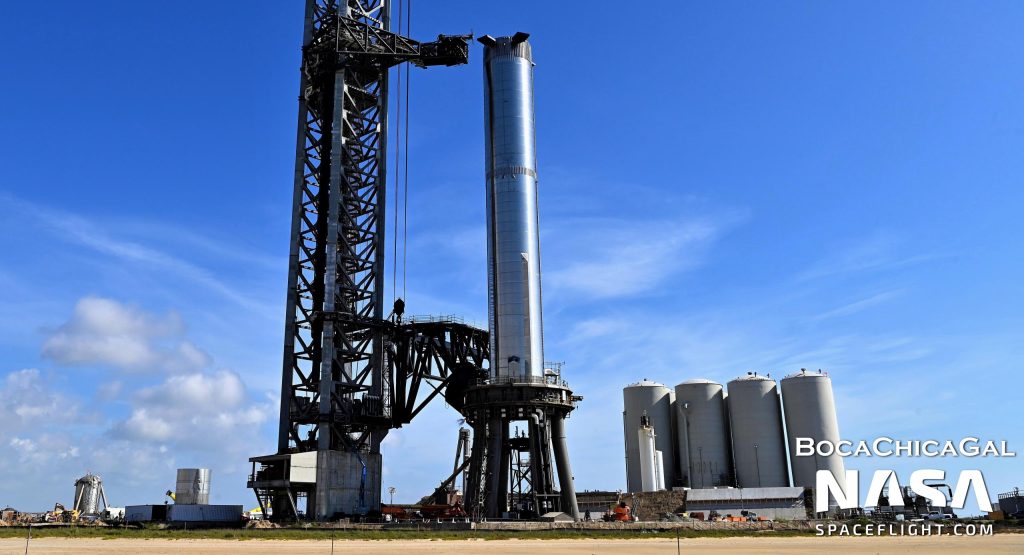
Building, qualifying, shipping, and installing 33 new Raptor 2 engines on Super Heavy B7 was already an impressive achievement and produced the most (potentially) powerful rocket booster ever assembled. On July 2nd, a pair of photos published by SpaceX showed off Booster 7’s nearly-finished engine section and simultaneously revealed that the company has finished installing all six of Starship S24’s Raptor engines – and even part of the ship’s aft thermal protection.
Differences are already visible between Ship 24 and Ship 20, the only other Starship prototype to have six Raptors installed. The most notable change is the addition of a metal framework that covers the entire breadth of the ship’s aft – most likely destined to support flat sections of insulation and thermal protection that will partially seal off sensitive engine, plumbing, pressure vessels, and avionics components located inside Starship’s aft. That extra shielding should help limit the extreme conditions that hardware will be subjected to during ground testing and, perhaps, in flight.
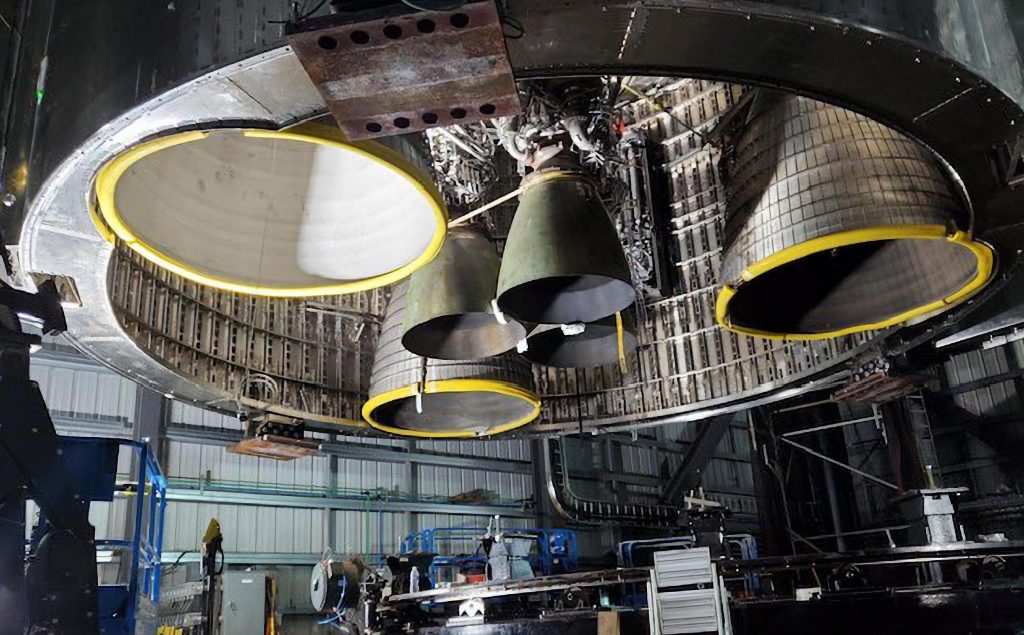
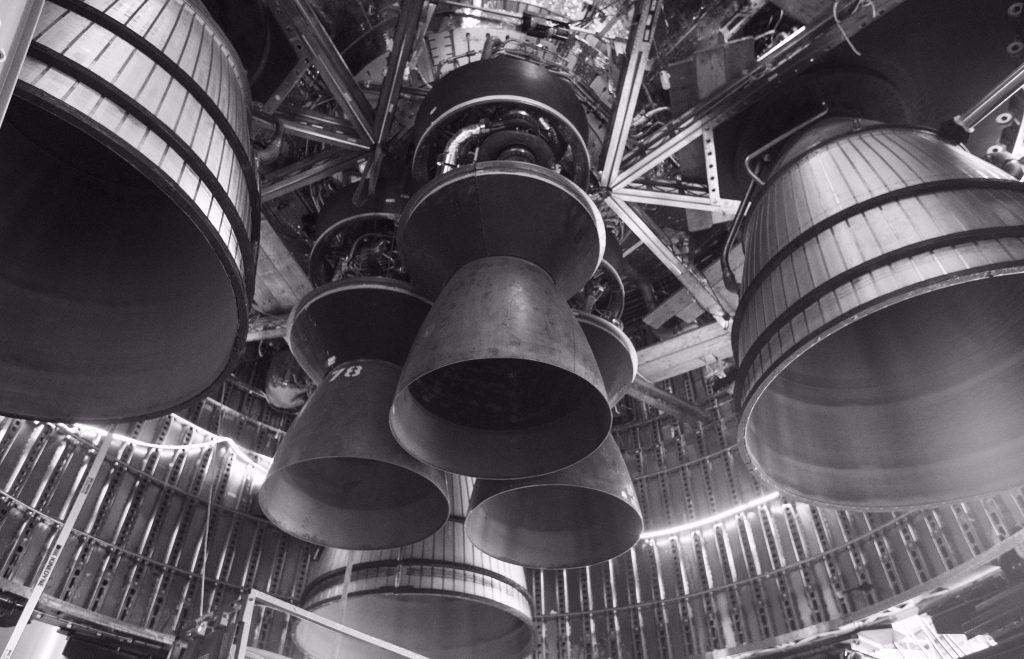
Super Heavy Booster 7 has already completed a significant amount of testing, including four cryogenic proofs (cryoproofs) and one Raptor thrust simulation test. Since its third return to the pad, SpaceX has several more ambiguous tests, none of which appeared to involve cryogenic propellant loading. It’s possible that those tests focused more on Booster 7’s pressurization system, perhaps filling its tanks with the hot oxygen and methane gases it will eventually use to pressurize its tanks. It’s likely that SpaceX wants to put Booster 7 through at least one successful wet dress rehearsal – using real liquid methane and oxygen propellant – before attempting to static fire any of its 33 Raptors. Booster 7’s aft thermal protection system also isn’t entirely complete, so technicians will need to finish installing several more panels before any static fire testing.
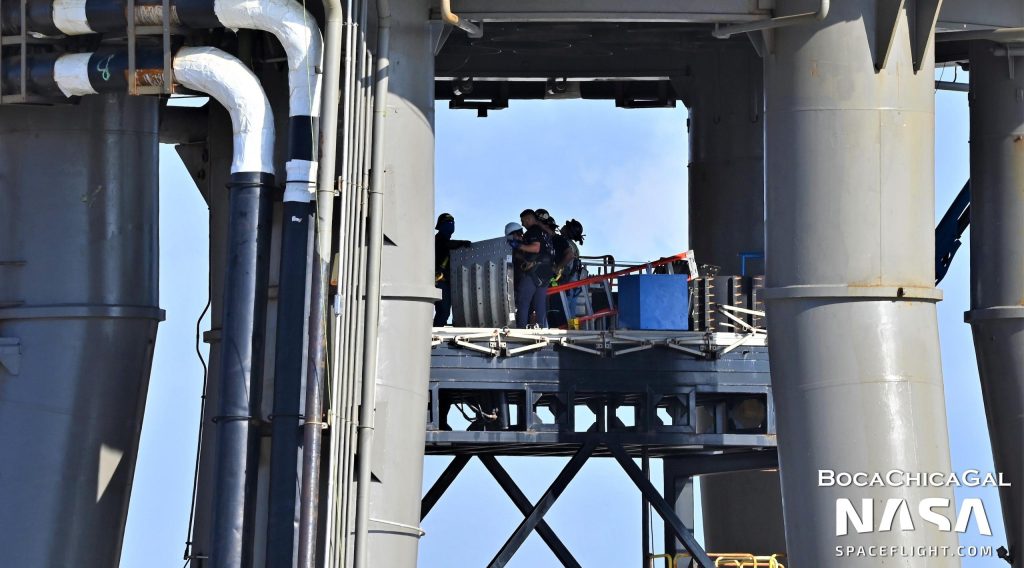
Alongside B7, Starship S24 has completed a good amount of cryoproof and Raptor thrust simulation testing, which it survived without any irreperable issues. The ship was then returned to an assembly bay on June 9th, where where workers have been installing heat shield tiles, finalizing the ship’s engine section, and completing dozens of other less visible closeout tasks. SpaceX also recently finished modifying one of its two suborbital test and launch mounts for Starship static fire testing, leaving the other mount semi-permanently modified for cryoproof and thrust simulation testing of future prototypes.
SpaceX has requested permission for road closures – each a potential 12-hour test window – on July 5th, 6th, 7th, 11th, and 12th.

Elon Musk
Elon Musk’s Biggest Revelations on AI, Robots, and the Future of Work from the Moonshots Podcast

Elon Musk’s appearance on the Moonshots with Peter Diamandis podcast was packed with bold predictions, candid admissions, and surprising tech insights. The nearly three-hour conversation covered everything from artificial intelligence to humanoid robots, geopolitics, and the future of work. Here are the top 10 most intriguing takeaways:
-
Aggressive AGI Timeline Predictions
Musk offered a detailed view on when artificial general intelligence (AGI) could emerge, suggesting it may arrive sooner than many expect, emphasizing both transformative potential and risks.
-
U.S. vs. China in the AI Race
He discussed the strategic competition between the United States and China over AI development, noting that geopolitical dynamics will shape how and who leads in the next decades.
-
Future of Job Markets
Musk touched on how AI and automation could reshape employment, predicting massive boosts in productivity alongside potential disruptions in traditional work structures.
-
Clean Energy Transition
A recurring theme was the role of clean energy in future economies, with Musk reiterating the importance of scaling sustainable power generation and storage.
-
Humanoid Robots Are Coming
On the podcast, Musk elaborated on Tesla’s work on humanoid robots, hinting at timelines and applications that go beyond factories to general-purpose assistance.
-
Tesla Roadster “Last Human-Driven Car”
Outside the core discussion topics, Musk teased features of the upcoming Tesla Roadster — calling it “the best of the last of the human-driven cars” and suggesting safety won’t be its main selling point.
-
The Role of AI in Clean Energy and Robotics
Linking AI to both energy optimization and robotics, Musk explained how smarter systems could accelerate decarbonization and task automation across industries.
-
U.S. Innovation Leadership
Musk argued that maintaining American leadership in key tech sectors like AI, space, and robotics should be a national priority, with thoughtful policy and investment.
-
Job Creation vs. Job Elimination
While acknowledging automation’s disruptive effects, he also outlined scenarios where new industries and opportunities could emerge, particularly in AI, space, and advanced manufacturing.
-
Long-Term Vision for Humanity
Throughout the conversation, Musk revisited his long-term philosophical views — including a belief in humanity’s responsibility to become a multi-planetary and technologically empowered species.
Whether you agree with Musk’s optimism or not, the podcast offers a window into the thinking of one of the most influential figures in tech today, in and why his visions continue to spark debate and inspiration.
Elon Musk
Elon Musk just said some crazy stuff about the Tesla Roadster

Elon Musk appeared on the Moonshots podcast with Peter Diamandis today to discuss AGI, U.S. vs. China, Tesla, and some other interesting topics, but there was some discussion about the upcoming unveiling of the Roadster, the company’s electric supercar that will arrive several years after it was initially slated for release.
Musk made some pretty amazing claims about the Roadster; we already know it is supposed to be lightning-fast and could even hover, if Tesla gets everything to happen the way it wants to. However, the car has some pretty crazy capabilities, some of which have not even been revealed.
On the podcast, Musk said:
“This is not a…safety is not the main goal. If you buy a Ferrari, safety is not the number one goal. I say, if safety is your number one goal, do not buy the Roadster…We’ll aspire not to kill anyone in this car. It’ll be the best of the last of the human-driven cars. The best of the last.”
🚨 Elon on the Roadster unveiling, scheduled for April 1:
— TESLARATI (@Teslarati) January 6, 2026
Musk makes a good point: people who buy expensive sports cars with ridiculous top speeds and acceleration rates do not buy them to be safe. They hope they are safe in case of an emergency or crash, but safety is not at the forefront of their thoughts, because nobody buys a car thinking they’ll crash it.
The Roadster is truly going to push the limits and capabilities of passenger vehicles; there’s no doubt about that. Tesla plans to show off the new version car for the first time on April 1, and Musk has only hinted at what is possible with it.
Musk said back in November:
“Whether it’s good or bad, it will be unforgettable. My friend Peter Thiel once reflected that the future was supposed to have flying cars, but we don’t have flying cars. I think if Peter wants a flying car, he should be able to buy one…I think it has a shot at being the most memorable product unveiling ever. [It will be unveiled] hopefully before the end of the year. You know, we need to make sure that it works. This is some crazy technology in this car. Let’s just put it this way: if you took all the James Bond cars and combined them, it’s crazier than that.”
Production is set to begin between 12 and 18 months after the unveiling, which would put the car out sometime in 2027. Hopefully, Tesla is able to stay on track with the scheduling of the Roadster; many people have been waiting a long time for it.
News
Tesla launches hiring for Robotaxi program in its twentieth country
Overall, the hiring signals Tesla’s aggressive timeline for global dominance in autonomous mobility.

Tesla has launched a hiring initiative for its Robotaxi program in its twentieth country, as the company posted two new jobs in Thailand this week.
Tesla is hiring in Bangkok and Kowloon for the Vehicle Operator position, which is related to data collection, and is the first in Thailand, but the twentieth country overall, as the company tries to expand into other markets.
🚨 BREAKING: Tesla is hiring additional full-time Vehicle Operators in Bangkok, Thailand.
Previous openings were 6-month, part-time roles. These are equivalent to AI Safety Operator roles in the U.S. pic.twitter.com/R6LzoU1bos— Tesla Yoda (@teslayoda) January 5, 2026
Tesla has had active job postings for Vehicle Operator positions in the United States, India, Israel, Taiwan, Germany, the Czech Republic, Hungary, the UK, Finland, Switzerland, Sweden, the Netherlands, Austria, Spain, Norway, Italy, and Turkey in past listings.
These postings are not all currently available, likely because the roles have been filled.
Thailand is the most recent, and broadens the company’s potential path to expanding its ride-hailing program, which is only active in the United States in Austin, Texas, and the California Bay Area, so far.
These roles typically involve data collection, which assists in improving Autopilot and Full Self-Driving operation. Tesla’s self-driving programs utilize real-world data that is accumulated and stored, observing vehicle and traffic behavior, as well as tendencies that are performed by human drivers to help increase safety and overall performance.
Overall, the hiring signals Tesla’s aggressive timeline for global dominance in autonomous mobility. Although the company has several high-profile rivals and competitors in the field, it has established itself as a main player and a leader in the development of autonomous technology, especially in the U.S., as its FSD suite is refined on almost a weekly basis.
The Full Self-Driving suite is available in seven countries and territories currently, including the U.S., Canada, China, Mexico, Puerto Rico, Australia, and New Zealand. Its biggest goal for expansion is currently the European market, where regulatory hurdles have been the main bottleneck prolonging its launch on the continent.
Tesla has performed months of testing in various European countries, including France and Spain, and does have support in some areas from various regulatory agencies. However, the company is hoping to get through this red tape and offer its suite in Europe for the first time, hopefully this year.








